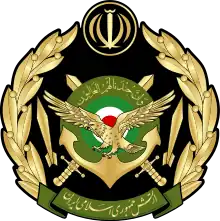Mahmoud Baharmast | |
|---|---|
| Born | 1899 Tehran |
| Died | 1977 (aged 77–78) Tehran |
| Allegiance | Imperial Iran |
| Years of service | 1920s–1953 |
| Chief of Staff of the Imperial Iranian Army | Major general |
| Alma mater | Fontainebleau Military Academy |
Mahmoud Baharmast (1899–1977) was an Iranian major general who served as the chief of staff of the Imperial Army in Iran in the period 1952–1953.
Early life and education
Baharmast was born in 1899 in Tehran.[1] He graduated from Dar al-Fonun, St. Louis School, Tehran, and Mushir al-Dawla School.[1] He joined the Iranian army.[1] In 1923 he was sent to Europe by the Ministry of War to continue his studies and graduated from the Fontainebleau Military Academy, France, specializing in artillery.[1]
Career and activities
Following his return to Iran Baharmast worked at different units of the army and in 1942 he was promoted to the rank of brigadier general.[1] Then he was first appointed head of the artillery unit of the army and then head of the general administration.[1] His next post was the commander of the military academy and of the war academy.[1] Then he was promoted to the rank of major general.[1]
Baharmast was appointed chief of staff of the Iranian Army in October 1952 and succeeded Morteza Yazdanpanah in the post.[2] Baharmast's term ended in March 1953,[3] and he was replaced by Taghi Riahi in the post.[4][5]
While in office Prime Minister Mohammad Mosaddegh accused military officers, including Baharmast, of not listening to his orders but to the orders of Shah Mohammad Reza Pahlavi.[5] Before the coup d'état in 1953 US officials approached Baharmast and other military officers who had pro-American and anti-Communist stance to eliminate the pro-Soviet and pro-Mosaddegh tendencies in the Iranian army.[6]
Later years and death
After Mohammad Mosaddegh was sent to exile Baharmast was invited to continue his military career, but he did not accept the offer.[1] He dealt with studies on the etymology of the Persian words.[1] In 1977 he died in Tehran while being blind in both eyes.[1]
References
- 1 2 3 4 5 6 7 8 9 10 11 "محمود بهارمست". Rasekhoon. Archived from the original on 10 January 2022. Retrieved 10 January 2022.
- ↑ Darioush Bayandor (2010). Iran and the CIA. The Fall of Mosaddeq Revisited. London: Palgrave Macmillan. p. 63. doi:10.1057/9780230277304. ISBN 978-0-230-57927-9.
- ↑ "Historical Documents. Persons". US State Department. Archived from the original on 10 November 2021. Retrieved 10 January 2022.
- ↑ Morteza Mir Hosseini. "مرگ سرتيپ رياحي". Etemad (in Persian). Archived from the original on 6 August 2021. Retrieved 10 January 2022.
- 1 2 Gholam Reza Afkhami (2009). The Life and Times of the Shah. University of California Press. pp. 150, 155. ISBN 978-0-520-94216-5.
- ↑ Darius Wainwright (2022). American and British Soft Power in Iran, 1953-1960. A 'Special Relationship'?. Cham, Switzerland: Palgrave Macmillan. p. 91. doi:10.1007/978-3-030-88414-7. ISBN 978-3-030-88413-0. S2CID 245008871.
External links
 Media related to Mahmoud Baharmast at Wikimedia Commons
Media related to Mahmoud Baharmast at Wikimedia Commons
